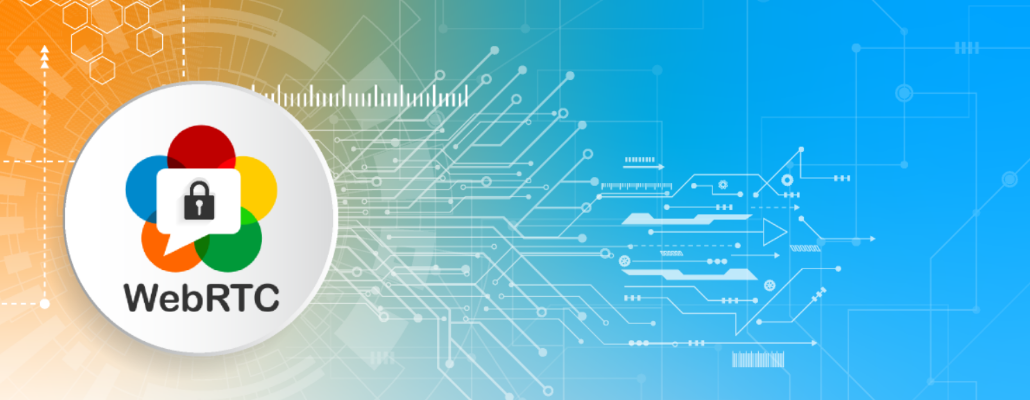WebRTC stands for web real-time communications, a very exciting, powerful, and highly disruptive cutting-edge technology that came out in 2011 and has grown ever since.
Let’s s understand the WebRTC is all about
What is WebRTC?
WebRTC is an HTML5 specification that you can use to add real-time media communications directly between browser and devices. In other words, WebRTC facilitates voices and video communication to work inside web pages.
Came in 2011 WebRTC progressed a lot, in its adoption and growth, By 2016 its popularity was estimated that 2 billion browsers installed that are enabled to work with WebRTC.
Web Real-time Communications (WebRTC) stimulates peer-to-peer, real-time communication in web browsers, and mobile applications through application programming interfaces. It is open-source and entirely free to use. It comes with a JavaScript API coating to make it as easy as feasible to incorporate real-time communications.
How does WebRTC works?
To provide real-time communication from the browser to the browser requires a lot of tech stack that works well together: audio and video processing, application, and networking APIs, and further network protocols for real-time streaming. The final result comes as WebRTC — with over plenty of varied standards for the application protocols and browser APIs that enable real-time communication for the web, makes WebRTC (real-time communication) work.
An overview of the WebRTC technology stack:
WebRTC is a blend of many different technologies and building blocks, making it a fairly detailed and complex system. Let’s take a brief overview of the WebRTC tech stack-
Web API – At the prime of the technology stack of the WebRTC is Web API, which is strengthened and maintained by the W3C. The Web API is a JavaScript API that application developers use to create a real-time communication application in the browser.
WebRTC C++ API – The next we have is the C++ API for WebRTC that allows browser makers to carry out the JavaScript-based Web-API. This tech stack of the WebRTC enables the browser to execute the Peer Connection API, which operates the full lifecycle of solidifying and maintaining a peer-to-peer connection between the two browsers, which oversees the delivery of a single real-time communication stream.
VoiceEngine – The VoiceEngine is a framework for the browser to implement the audio media capture, VoiceEngine is fabricated by diverse and different standards that regulate different tasks like-
- The audio codecs (iSAC, iLBC, and Opus).
- Echo cancellation algorithms.
- A noise reduction component.
The internet Speech Audio Codec (iSAC) is a standard evolved by Global IP Solutions, it is aimed at wideband network conditions where bitrates may be low and packet loss, delay, in the wide-area network.
The Internet low bitrate codec (iLBC) is a narrowband speech codec for VoIP and streaming audio, it is well fitted to poor network conditions.
Opus is an intra-frame audio coding format homogenize and entails technology that is already deployed by Skype, it is an adjustable codec that can deal with a wide range of audio applications, may it be Voice over IP, videoconferencing, in-game chat, or even remote live music performances.
VideoEngine – VideoEngine, contributes the much same work module as the VoiceEngine, just the VideoEngine is modified to stream videos. VideoEngine furthermore likewise is also aimed at taking a raw video capture from the device and furnishing it to transport over the web.
Transport – The considerably important part of the Real-Time Protocol that delivers an adaptive stream of data over the web is Transport, after audio and video data processed and encoded, it needs to be sent over the network, which is administered by the Transport over UDP.
UDP empowers the backbone to build real-time communication applications. UDP provides a delicate wrapper over basic IP delivery. It is a simple protocol to use promptly for WebRTC.
WebRTC layers three additional protocols on top of UDP:
- Datagram Transport Layer Security (DTLS) is used to intervene with private keys for encrypting media data and to secure transport of application data.
- Secure Real-Time Transport (SRTP) is used in transporting audio and video streams.
- Stream Control Transport Protocol (SCTP) is used in transporting the application data.
Also Read: – Things to Consider while Developing a live Video streaming app Like Twitch?
WebRTC is Beyond just Video and Audio Calls:
WebRTC isn’t limited to voice and video. It allows sending any type of dictatorial data and also –
- WebRTC is completely free
- It comes as an open-source project that has been entrenched in browsers but one can take and modify it, according to their own needs.
- This in bend has created a rich and dynamic ecosystem around WebRTC of an assortment of open-source projects and frameworks as well as marketable subsidies from companies that assist to build your products.
- WebRTC has constantly evolved and improved so much that one needs to keep a watch on it.
Is WebRTC Secure?

WebRTC proposes an exhilarating value bid, namely in-browser audio, video, and data communication without plugins, it puts forward critical security questions like – Is it secure to use? what must developers enforce to ensure this security?
Well, All WebRTC components have obligatory encryption, and all JavaScript APIs require secure origins via HTTPS or localhost. The major security question for developers is when carrying out WebRTC inhabits in using proper and secure protocols. Signaling methods, or the techniques used to swap meta-data, are not prescribed in WebRTC and are left to you to implement. This gives you enough flexibility to create your app in a way that fits best for your use case.
Why should you opt to use WebRTC
WebRTC compels no plugins, frameworks, or applications, all you need is a WebRTC consistent browser. To an end-user, WebRTC applications work just right out of the box. No JavaScript API, just pure video, audio, and data communication on any webpage.
WebRTC totally peers to peers, so you don’t have to reimburse for any of the bandwidth across the wire. Besides, because WebRTC is entirely browser to browser, you get outstanding performance and the worst latency possible.
What is Peer-to-Peer Connection?
Peer connections are part of the WebRTC specifications that deal with connecting two applications on different computers or mobile phones to communicate using a peer-to-peer protocol. WebRTC is manufactured to work peer-to-peer, so users can engage by the most direct route possible. The communication between peers can be video, audio, or arbitrary binary data
To ascertain a peer-to-peer connection, there are few steps involved to allow clients to:
- To be available for communication
- recognize each other and share network-related information
- share and agree on the configuration of the data, mode, and protocols involved
- share data
Pros of webRTC:
- It is an Open source code
WebRTC is an open-source code established project which has been resolved for data streaming between apps and browsers. This communication standard is substantiated using peer-to-peer technology. Google is the original developer of this technology, but today WebRTC is upheld not only by Google Chrome, but also by Yandex, Opera, and Firefox browsers.
- Independent Platform and Device
WebRTC is evaluated as the game-changer in terms of communications standards with infinite possibilities for creation. It permits developers to write HTML5 code that can work on desktop as well as on mobile devices. It can effortlessly be implanted in browsers with any operating system and a web services application. It can oversee the browser to create a real-time voice or video connection to another WebRTC device or media server.
- security and stability
Even though this communication standard is still in the process of advancement and development, there are specific clear advantages of WebRTC over Flash technology. When it comes to browser security and stability against outward invasions, WebRTC is certainly the best choice.
- Supported by most leading Web Browsers and Platforms
WebRTC is largely implemented by using the C/C++ library and it comes with a Javascript API, which is also underwritten by most leading Windows browsers, comprising Google Chrome, Opera beta, Yandex, and Firefox. This brings about, it is far easier to formulate and integrate real-time communications anywhere involving existing online businesses.
- Advanced Voice and Video Quality
WebRTC wields the Opus audio codec which is based on Skype’s SILK codec technology that generates high steadfastness voice. it utilizes a VP8 codec for video transmission. WebRTC with its progressive and adaptive network solutions such as Real-time Control Protocol (RTCP) and Secure Audio Video Profile with Feedback (SAVPF) compensates and adjusts to changing network conditions and making WebRTC outstanding in its voice and video quality.
- A great impact on market
Real-time communication is coming to be the norm across any industry. WebRTC, with its multi-features, communications capability, provides numerous different forms of communications that hold great importance on leaving an impact on the job as well as tech market.
Cons of WebRTC:
- Yet under the process of development
Web Real-time Communication is still under development. This disadvantage of this communication standard is deemed as the major drawback of WebRTC, since the code developed it has undergone many important changes, even shortly. The existing WebRTC API version 1.0 which is only a working draft.
- Solutions incompatibility
WebRTC solutions are incompatible with each other. The standard commonly pertains only to the techniques of video and audio transmission, while agents are free to decide on signaling, messaging, file transfer, conference schedule, etc.
- Technical hurdles
WebRTC has its technical difficulties like There is a high odds that the transmitted file will be damaged: the image may shake, get blur, pixels may be visible, etc.
- Incertitude regarding the future codecs
One of the serious problems among WebRTC disadvantages is the list of vital codecs. All the participating companies have agreed at the term to only one thing – They came to an agreement that WebRTC’s primary codec will be cross-platform and supported by all browsers. To date, there has been a use of the royalty-free VP8 codec.
Use cases of real-time communications:
WebRTC holds up billions of minutes and is used every day for real-time video and audio calls. some use cases are as follows –
- Robotic Process Automation/Controller – this field deals with a specific category of controlling Remote Bots. WebRTC comes to salvation while building the core platform by capturing the media source feed shared by the Remote bot and notifying adequate commands to them using secure and fast Data Channels.
- Video Chat – As It has been established by now that video chat is the bread and butter of Real-time Communication. The framework already powers two-way communication. WebRTC video chat to steer engagement and heighten the end-user experience in more unusual applications.
- Speech Synthesis, Transcription, and Analytics – Speech synthesis, transcription, and analytics implicate analyzing acoustic, linguistic behavior of audio waveform in a particular context and using Deep Learning models to convert into text or vice-versa.WebRTC comes to the help here for procuring cross-platform Audio that can be highly customized and comes with heavy statistics.
- Monitoring and Surveillance – WebRTC has laid the stone of its way into doorbell cams, smart city technologies, wearable health devices, customer baby monitors, and drones. When real-time audio and video deliver value, WebRTC makes it possible.
- Multiple Enterprise Communication – WebRTC proves useful for browser-based streaming at scale, enterprise communication nowadays happens in the form of a marketing webinar or an all-hands meeting, WebRTC source stream into an HTTP-based protocol like HLS or DASH. presenters can circulate their video streams directly from the browser with just a webcam and microphones and connect to multiple users.
- Online Education and e-learning – Remote learning has made its space in the world solid, it takes the form of both combined video chats and one-to-many or one-on-one lectures. The WebRTC workflow can strengthen any number of online education applications by delivering instant access to video content within browsers.
Also Read: – How Much Does It Cost to Build a Voice Chat App For Gamers like Discord?
WebRTC is the future of online communication:

With having more than 5 billion users today, WebRTC is a transport of social media that allows online communication and video chatting. WebRTC is here to stay and is going to take the place of current solutions in the future.
If people prefer remote working anywhere, WebRTC is what will enable business continuity from the office, home, and on the road.
WebRTC is the future, with its amazing features and the capability to do much especially in the era, the Future of webRTC looks super bright.
Wrapping up: –
Web Real-time Communication has a lot of possibilities and potential in the near future, it may or shall I say it will gain an even bigger share of the communication market shortly.
If you are skeptical of what WebRTC option is right for you, consider investing in a company that can assist you to guide you through. This is a great first step for those who are looking for a path forward for their Real-time audio, video, and chat project.
If you are looking for the best IT company, look no more as we got you covered. ThinkStart Private Limited is an excellent mobile app development company in USA.
How can ThinkStart help you with WebRTC?
ThinkStart offers SDKs, server tech stacks, and professional services that enable companies to skillfully integrate live video, voice, messaging, and more into their applications. ThinkStart Pvt Ltd. develops enterprise-quality on-demand products, ThinkStart also has a dedicated and skilled team that provides a wide range of services to help companies advance their application development.
Know more about Web Real-time Communication or discuss your project with ThinkStart, to contact ping us at – [email protected].




























